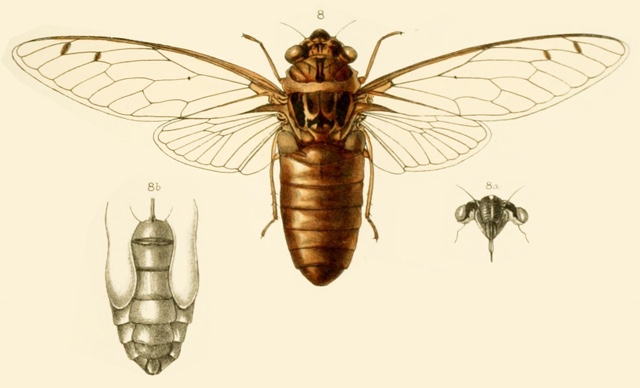Champaka meyeri (Distant, 1883) is a cicada found in Indonesia.
Champaka meyeri was formerly known as Cosmopsaltria majuscula.
Scientific classification:
Family: Cicadidae
Subfamily: Cicadinae
Tribe: Dundubiini
SubTribe: Dundubiina
Genus: Champaka
Species: Champaka meyeri (Distant, 1883)

Species (Cosmopsaltria majuscula) description from A Monograph of Oriental Cicadas by W.L. Distant:
Body above warm-ochraceous. Head with the front, — excepting base and apex, — the area of the ocelli, and a larger spot on inner margin of eyes, dark castaneous; eyes ochraceous, with their inner area olivaceous. Pronotum with a broad central longitudinal castaneous fascia and a small castaneous spot near anterior lateral margin. Mesonotum with five blackish fasciae, the central one very slender and joining a triangular fascia in front of basal cruciform elevation, on each side of the central fascia is a short and broader one, and the lateral fasciae are long, broad and slightly curved. Abdomen above ochraceous. Body beneath ochraceous; the face blackish, with a central ochraceous spot near anterior margin, and a black marginal spot between eyes and face; legs pale castaneous, the inner margins of anterior femora blackish, anterior and intermediate tibiae and tarsi somewhat darker castaneous, the posterior tarsi ochraceous.
Tegmina and wings pale hyaline, the venation ochraceous, but becoming fuscous towards apical areas; the tegmina with the costal margin fuscous beyond base of upper ulnar area, and the transverse veins at bases of second and third apical areas infuscated.
The body is long and broad; the rostrum reaches the posterior coxae; the opercula are slender and placed widely apart, concave on each side beyond base, but very slightly so outwardly, the apices rounded and reaching the fourth abdominal segment.
References:
- The illustration, description and location information comes from A Monograph of Oriental Cicadas by W. L. Distant. 1889-1892. Read it on the Biodiversity Heritage Library website.
- Species name information comes from Allen Sanborn’s Catalogue of the Cicadoidea (Hemiptera: Auchenorrhyncha).